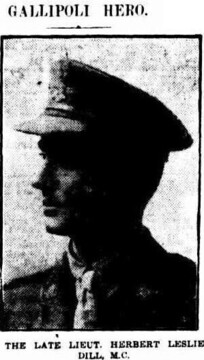DILL, Herbert Leslie
| Service Number: | 2586 |
|---|---|
| Enlisted: | 9 June 1915 |
| Last Rank: | Private |
| Last Unit: | 3rd Infantry Battalion |
| Born: | Toogimbie Station, Hay, New South Wales, Australia , 1893 |
| Home Town: | Condobolin, Lachlan, New South Wales |
| Schooling: | Newington College, Sydney, New South Wales, Australia |
| Occupation: | Station Hand |
| Died: | Sydney, New South Wales, Australia , 29 June 1923, cause of death not yet discovered |
| Cemetery: |
Randwick General Cemetery, New South Wales |
| Memorials: | Condobolin Public School Great War Memorial Gates |
World War 1 Service
| 9 Jun 1915: | Enlisted AIF WW1, Private, 2586, 3rd Infantry Battalion | |
|---|---|---|
| 9 Aug 1915: | Involvement Private, 2586, 3rd Infantry Battalion, --- :embarkation_roll: roll_number: '7' embarkation_place: Sydney embarkation_ship: HMAT Runic embarkation_ship_number: A54 public_note: '' | |
| 9 Aug 1915: | Embarked Private, 2586, 3rd Infantry Battalion, HMAT Runic, Sydney |
Help us honour Herbert Leslie Dill's service by contributing information, stories, and images so that they can be preserved for future generations.
Add my storyBiography contributed by Stephen Brooks
Herbert Leslie Dill was the son of John and Ellen Dill, who were well-known graziers in the Condobolin district. Herbert was educated at Newington College, and later engaged in the grazing industry. He enlisted early in 1915, when 22 years of age, and left Australia in the same year with reinforcements to the 3rd Battalion. He joined the battalion on Gallipoli in late 1915, and later proceeded with it to France where he was wounded at Pozieres during July 1916 and evacuated to England. He returned to the Battalion during October 1916 and was soon promoted to Sergeant then Second Lieutenant.
He was awarded an MC for his gallantry at Hermies in France on 15 April 1917. In the same action he was most severely wounded by a bullet in the back. He was evacuated to Britain after long periods in English hospitals, returned to Australia on 3 July 1917.
He was reported to have never really recovered from the effects of his wounds.
He passed away in the Prince of Wales Hospital in Randwick, on 29 June 1923. He was reported as extremely popular with the members of the 3rd Battalion, and a number of his old comrades attended his funeral, where he was buried with military honours in the Randwick Cemetery.










